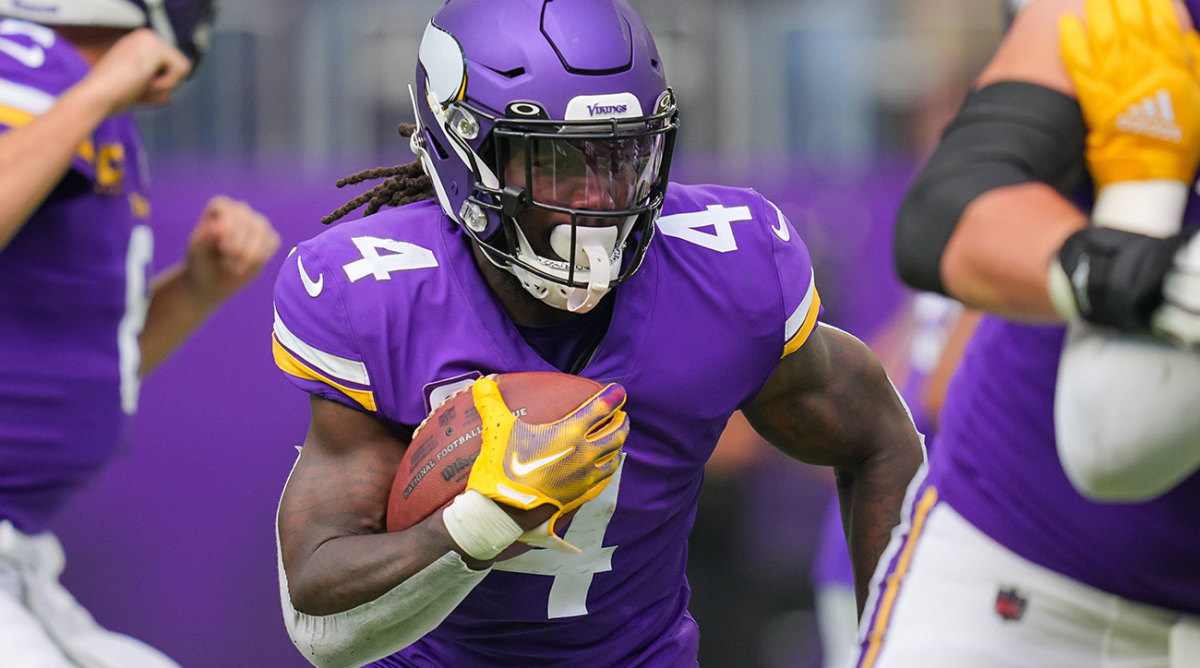The 10 Best Landing Spots for Dalvin Cook

Dalvin Cook is officially available, with news coming out Thursday that the Vikings will release him if they can’t find a trade partner by the end of the week. The seventh-year running back, who will turn 28 before the start of the season, has made the Pro Bowl each year since 2019. He has not rushed for fewer than 1,100 yards in a season since ’18 and has rushed for 43 touchdowns in the past four seasons.
This is about as excited as we can get about a 28-year-old running back who may end up as more of a complementary, rotational piece during the 2023 season than a feature back. The Vikings were high enough on Alexander Mattison to comfortably move on from Cook before the start of training camp. Their relatively thin backfield should be kept in mind when we wonder how a player this noteworthy has emerged on the market (meaning the Vikings may have seen him as not just expensive but very expendable).
Still, there will be a market. Cook and Ezekiel Elliott remain capable veteran bodies who can be a net positive to an offense, even if they may not end up being pace-setting backs anymore. Here we’ll explore a few places where Cook may fit.

1. Miami Dolphins
Cook has been heavily tied to the Dolphins since rumors of a Vikings split first materialized. He would be placed in the capable hands of Miami assistant head coach Eric Studesville, who has been one of the top running backs coaches in the NFL since the turn of the millennium. Mike McDaniel prioritizes top-end speed, and Cook, even late into last season, flashed the ability to pull away from a chase pack once he broke a run into the second level. Former Vikings offensive coordinator Klint Kubiak, who oversaw one of Cook’s best seasons, is now a passing-game coordinator with the 49ers, embedded in the same Kyle Shanahan scheme that birthed McDaniel’s star rise in the NFL. The Dolphins and the Vikings had an almost identical split between zone- and gap-style runs last year, according to Sports Info Solutions, though Miami’s heavier use of backfield motion could allow Cook to see some lighter boxes (even though Justin Jefferson helped in that regard, as Cook faced eight or more defenders in the box on just 18% of his runs last year, according to NFL’s Next Gen Stats).
2. New York Jets
For the same schematic reasons the Dolphins should be interested, the Jets will be as well. While this team will be happily paced by the recovered second-year back Breece Hall, his torn ACL from a year ago looms large. The Jets lacked a true home run hitter at the position before Hall’s emergence, which is a bit of an Achilles heel for teams running outside zone. Outside of the true bonus, that signing Cook ensures the division-rival Dolphins cannot, the Jets would get a volume receiver who can help Aaron Rodgers at the line as a checkdown target.
3. Dallas Cowboys
Personally, I think the Cowboys’ biggest problem right now is pass protection from the running back position, which is why I’d still consider re-signing Elliott if he is amenable to lesser contract terms. Tony Pollard is an excellent pass protector, but what happens if he struggles to return from his broken fibula or reaggravates the condition? Cook is less of a backfield bodyguard, but he would offer the Cowboys division-altering speed and much-needed depth. I think Mike McCarthy was always going to be more comfortable with a secondary option with experience.
4. Philadelphia Eagles
Why the Eagles? Because they’re the Eagles. No other reason. This team is so obsessed with adding quality depth and has an owner actually willing to pay for it. Yes, Philly is absolutely loaded at the position right now and just stole D’Andre Swift away from the Lions for next to nothing. But, when a good veteran player is on the market, Howie Roseman’s name simply has to come up, much like Bill Belichick’s did during the height of the Patriots’ dynasty.
5. Cleveland Browns
The Browns are an obvious scheme fit. Coach Kevin Stefanski was in Minnesota when the Vikings drafted and developed Cook. The Browns’ offense is certainly patterned after some of the later-year Kirk Cousins Vikings teams, and, with Kareem Hunt no longer on the roster, the Browns could use a secondary back to take the stress off Nick Chubb. Stefanski has pivoted a bit more to a gap-run scheme in Cleveland, however, and it would be worth wondering whether Cook and Stefanski could come to a middle ground that provided Cook some degree of comfort.
6. Baltimore Ravens
I’d wonder whether the Ravens’ spree of running back injuries two years ago still has the team reeling a bit. Gus Edwards is still the primary backup to J.K. Dobbins, who has appeared in just 22 games over the past three seasons. Bringing in Cook would present a viable, veteran alternative and also keep him away from the Browns. We don’t exactly know what new OC Todd Monken’s offense will look like, but we do know it might be appealing for a back who has never played with a mobile quarterback to experiment there. Cook spent his entire career in a play-action-heavy Vikings offense with the stationary Cousins. Here, Lamar Jackson could take some stress off Cook and allow him to break big runs as more of a situational hitter.
7. New York Giants
The Giants pulled their long-term offer to Saquon Barkley and remain at a contractual impasse as they head into the franchise tag deadline. While the Giants also have veteran Matt Breida on the roster along with a fifth-round pick, Eric Gray, who is more of a stylistic complement to Barkley than a clone, Cook would give them the option to log some tougher miles. This is especially true given what a slog the Giants’ schedule is in 2023.
8. Cincinnati Bengals
The Bengals have not yet separated with Joe Mixon, and, while they are unlikely to commit big salaries to a pair of running backs, the loss of Samaje Perine put the team in a difficult position. Perine was one of the most dependable passing-down backs in the NFL and was targeted 51 times last season by Joe Burrow. Cook took in 56 targets a year ago and could handle the passing load, even if he might be a bit less effective as a specialist and red zone threat. At the end of the day, moves like this signify a willingness to get into an arms race. With the Eagles a year ago, we saw how important their willingness to make big free-agent acquisitions was. This could provide a similar payoff for the Bengals.
9. Carolina Panthers
The Panthers still have $27 million in cap space, and while they would not be the most attractive option for Cook in terms of immediate title contention, they could probably pay him more for the privilege. A running back is not necessarily the best friend of a developing quarterback, but Bryce Young would never say no to a capable backfield receiver and a backfield companion for Miles Sanders, one of the team’s most notable offseason signings. It’s clear Carolina viewed running back as a position of need. Perhaps that need is still pressing enough to make a move.
10. Buffalo Bills
The Bills drafted Dalvin’s brother, James, in the second round of the 2022 draft. Perhaps Dalvin would be an immediate insurance policy and a guiding force for James. The Bills have a smattering of different style backs behind James Cook, like Nyheim Hines and Latavius Murray. Dalvin Cook could represent a bit of an upgrade over Murray, and he could help mold James into a future 1,000-yard back. The Bills have become a destination of late for aging stars hoping to cling onto their fast-closing Super Bowl windows.
